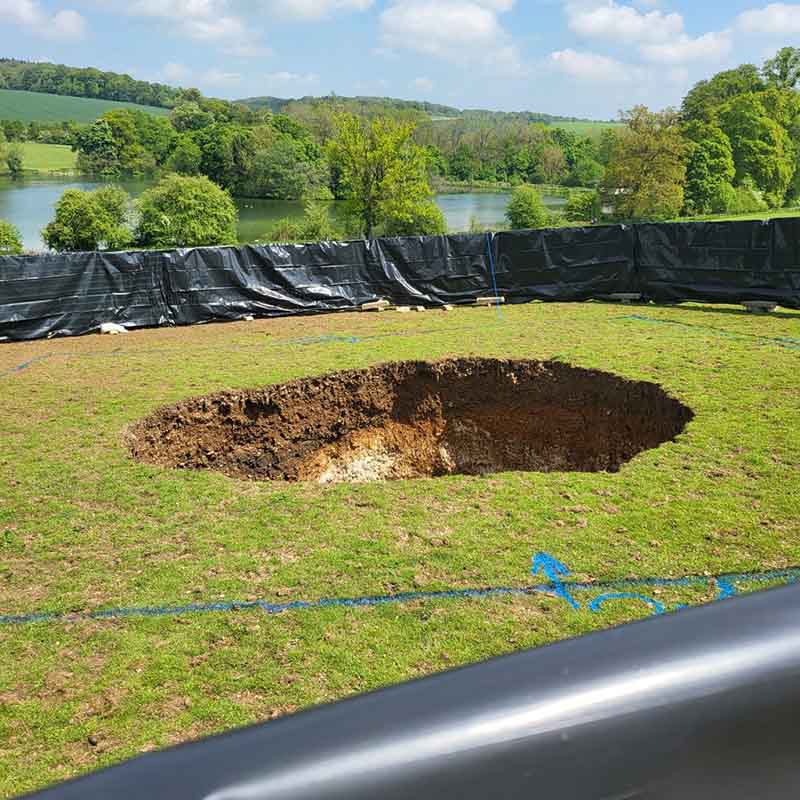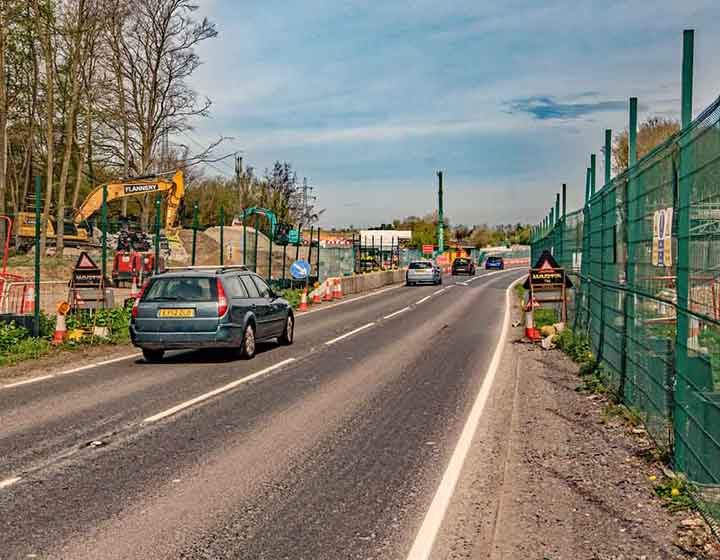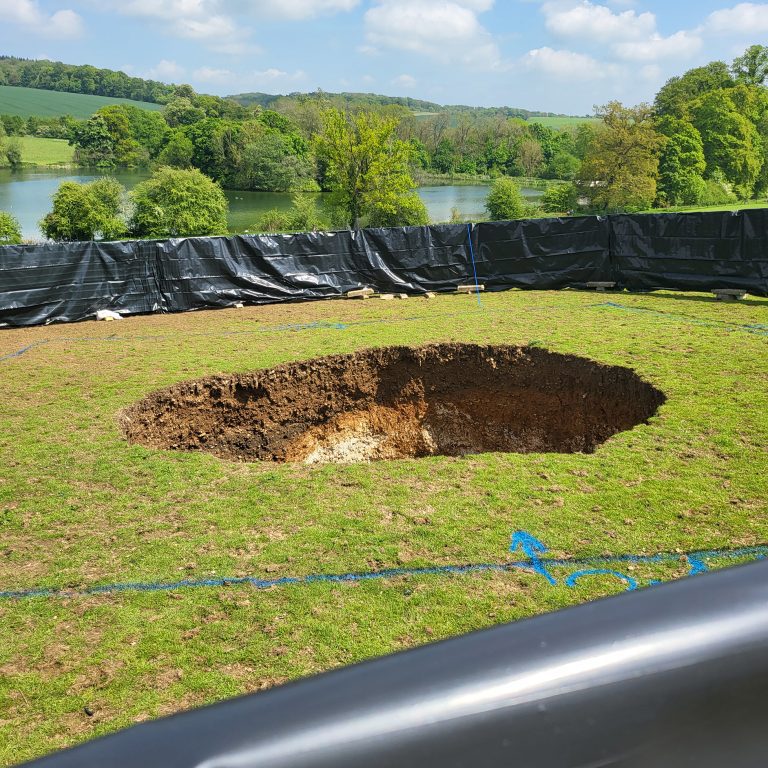Compiled on behalf of the Chiltern Society by the HS2 Working Group
During the early hours of Saturday, May 13th a sinkhole opened up in Shardeloes field about a hundred metres to the south of Shardeloes lake. The hole was approximately six metres in diameter and 5 metres deep. During the night, the ground had given way and a sinkhole had been created, thirty-two metres above the HS2 tunnel being drilled by the Tunnel Boring Machine (TBM) named Cecilia, which is cutting the westerly of the two tunnels, and some 50 metres behind the TBM boring the eastern tunnel.
Earlier in the week, on Tuesday May 9th, Cecilia had been stopped for routine maintenance. On restarting it ran through a “dissolution feature” – a void in the chalk – which contained large loose lumps of flint. These damaged the flexible pipework between the cutter head and spoil pipeline, which required another stop for repairs. This disturbance caused the unstable ground above the tunnel to fail and collapse. This was propagated back to the surface, creating the sinkhole.
This chain of events came as no great surprise to a number of interested parties, as the unconsolidated, unstructured nature of the chalk in this part of the Misbourne valley had been recognised and recorded several times in the past in both Geological Survey and HS2 ground investigation reports. The risks of such a collapse were highlighted by the Society in a report to HS2 in 2010 (see note below). The Misbourne valley follows the south-easterly alignment of two major fault zones, which gave rise to the valley in the first place.
Over the last half million years, ice action and active water flow over and through the chalk has eroded this soft rock away, creating what geologists call a “karst topography” or a landscape with a subsurface cut through by fractures, fissures and caves or voids – all known features in the valley.
When the chalk was eroded away, it was inevitable that the flint nodules which naturally occur in the sediment would get left behind, as they are resistant to erosion. It was a residual build-up of flint nodules in a void which had caused Cecilia to have mechanical problems on May 9th. Given the depth of the sinkhole at around five metres and the crown of the tunnel is at thirty-two metres, there are now twenty-seven metres of poorly consolidated soil, chalk and possibly an open void above the tunnel – this needs to be investigated and corrected. Align claim that additional grout pumped from the TBM has stabilised the feature, but there is no evidence that this is adequate to prevent further collapse.
During the HS2 Select Committee hearings, it was claimed that the Environment Agency (EA) would only permit operations to proceed if “all potential risks… have been mitigated”. Clearly this is not the case, and despite having received reports of the latest problem, the EA have not halted the tunnelling operations – so putting the river Misbourne and Shardeloes lake at risk.
The Chiltern Society wrote to Sarah Green MP, pointing out the failure of the EA to monitor or control the tunnelling operations. As the TBMs will shortly be passing under the river Misbourne, there is little time left to prevent further serious incidents from occurring; only the EA have powers to prevent this – which they are not exercising.
The Society believe that further Ground Investigation work is needed to eliminate the risk of another occurrence putting the River Misbourne at risk.
Note:
The Chiltern Society has raised the issue of unstable ground under the Misbourne valley, through which the two HS2 tunnels are being drilled, on numerous occasions in the past. As long ago as August 2010, in a report entitled “Concerns arising from the Geology and Hydrology of the ground underlying the High Speed (HS2) routes through the Chilterns” the Society’s Geological Adviser, Haydon Bailey stated:
The Chiltern Society has raised the issue of unstable ground under the Misbourne valley, through which the two HS2 tunnels are being drilled, on numerous occasions in the past. As long ago as August 2010, in a report entitled “Concerns arising from the Geology and Hydrology of the ground underlying the High Speed (HS2) routes through the Chilterns” the Society’s Geological Adviser, Haydon Bailey stated:
“All the routes… require extensive construction via tunnels and deep cuttings in order to cross the Chilterns and access the Vale of Aylesbury to the north. It will be impossible to do this without:
- Potentially causing long term damage to the Chalk aquifer system.
- Possibly causing pollution of the main water supply system for the north-western Home Counties area and potentially further into north London – with the subsequent need to source water from other, much more distant parts of the country.
- Running the risk of serious ground collapse in areas with deep sections of weathered chalk.
- Depressing the water table in the Misbourne valley, resulting in:
- the total loss of surface flow in the Misbourne River system, and the destruction of the adjacent habitats…
- and the aesthetic loss of the Misbourne River and its replacement by a dry valley
- causing the loss of both biological and geological SSSIs and a Regionally Important Geological Site.
Item 3 on the above list has been highlighted, as this has now proven to be correct. Is there the possibility of further similar ground collapse and sinkhole development? The answer to this is unknown, but if it has happened once, then the potential for it to happen again cannot be ruled out. There are geologists with a high level of expertise in chalk sinkholes who know the Misbourne valley well, but HS2/Align are currently choosing not to draw on this expertise.
A message from our Chief Officer 24 May, 2023
Our HS2 working group have been in discussion with all parties involved in the construction of HS2 at the most senior levels available, and will continue to do so.
The local MP, Sarah Green and Buckinghamshire Council have been working with us on the situation, and in regular contact, both I know raising the issue at the highest levels across Westminster Government.
If like me you are unhappy about how this is being handled, please do express your concerns to the Environment Agency via their complaints / general enquiries contact.
By post: National Customer Contact Centre, PO Box 544, Rotherham, S60 1BY
By email: enquiries@environment-agency.gov.uk
Telephone 03708 506 506 (but this may incur charges) Monday to Friday, 8am to 6pm.
Telephone from outside the UK (Monday to Friday, 8am to 6pm GMT) +44 (0) 114 282 5312.
Tom Beeston
Chief Officer at the Chiltern Society
Chief Officer at the Chiltern Society





